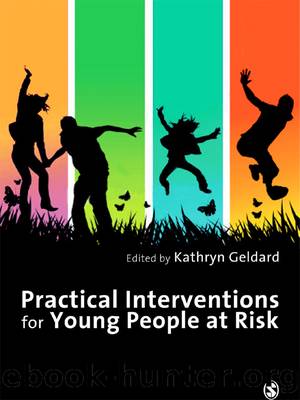Practical Interventions for Young People at Risk by Kathryn Geldard

Author:Kathryn Geldard [Geldard, Kathryn]
Language: eng
Format: epub
Tags: Nonfiction, Social & Cultural Studies, Social Science, Human Services, Social Work
ISBN: 9781473903197
Publisher: SAGE Publications
Published: 2009-07-09T04:00:00+00:00
The context of fire-setting: cognitive development
The nature and meaning of childrenâs involvement with fire is, in part, a function of their level of cognitive development. Preschool, or preoperational (Piaget and Inhelder, 1969), children have little capacity to understand cause and effect (Coppens, 1986) and transformations. Consequently, they have little ability to appreciate the danger inherent in even the smallest flame or understand how a small candle, match or lighter flame might become a large fire. In addition, parents often overestimate their childrenâs ability to understand this risk (Garling and Garling, 1995). Indeed, many common family practices â giving children candles to hold in church and blowing out birthday candles, for example â might actually support the preschool childâs notion that the small candle, match and lighter flames they are so familiar with are not particularly dangerous (Cole et al., 2006).
Primary school, or concrete operational, children do understand cause and effect and transformations, but many overestimate their own ability to control a small fire (Grolnick et al., 1990). This overestimation is enhanced by the concrete operational childâs failure to appreciate the full range of possible outcomes of a small fire suddenly getting out of control (Piaget and Inhelder, 1969). They cannot easily anticipate an outcome that they have not experienced. Grolnick et al. (1990) found that children who felt that they could extinguish a small fire were three times more likely than those who felt unable to extinguish a fire to self-report at least one instance of fire play. This sense of self-control was, in turn, related to greater exposure to household activities involving fire, more supervised experiences with fire, such as building campfires, more responsibility for chores involving fire (such as cooking) and greater access to ignition materials.
The young person, in the stage of formal operations, like the adult, does appreciate the full range of possible outcomes. There are no developmental limitations to the young personâs understanding of the risk of being involved with a fire. The misuse of fire or deliberate fire-setting in this age group is likely to be linked to risktaking or individual or family pathology.
Download
This site does not store any files on its server. We only index and link to content provided by other sites. Please contact the content providers to delete copyright contents if any and email us, we'll remove relevant links or contents immediately.
Spare by Prince Harry The Duke of Sussex(4195)
Machine Learning at Scale with H2O by Gregory Keys | David Whiting(2289)
Fairy Tale by Stephen King(2069)
Will by Will Smith(2041)
Hooked: A Dark, Contemporary Romance (Never After Series) by Emily McIntire(1958)
Rationality by Steven Pinker(1764)
The Bullet Journal Method by Ryder Carroll(1501)
The Becoming by Nora Roberts(1330)
Friends, Lovers, and the Big Terrible Thing by Matthew Perry(1327)
A Short History of War by Jeremy Black(1300)
HBR's 10 Must Reads 2022 by Harvard Business Review(1256)
The Strength In Our Scars by Bianca Sparacino(1244)
Can't Hurt Me: Master Your Mind and Defy the Odds - Clean Edition by David Goggins(1227)
515945210 by Unknown(1207)
Fear No Evil by James Patterson(1108)
Love on the Brain by Ali Hazelwood(1095)
Bewilderment by Richard Powers(1083)
This Family Does It by Kevin Sellers(1080)
443319537 by Unknown(1072)
